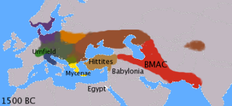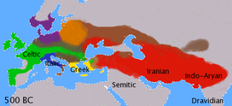This is an old revision of this page, as edited by Ajd (talk | contribs) at 21:26, 17 May 2005 (Baltic - see talk). The present address (URL) is a permanent link to this revision, which may differ significantly from the current revision.
Revision as of 21:26, 17 May 2005 by Ajd (talk | contribs) (Baltic - see talk)(diff) ← Previous revision | Latest revision (diff) | Newer revision → (diff)| Part of a series on |
| Indo-European topics |
|---|
 |
Languages
|
| Philology |
Origins
|
|
Archaeology
Pontic Steppe Caucasus East Asia Eastern Europe Northern Europe Pontic Steppe Northern/Eastern Steppe Europe
South Asia Steppe Europe Caucasus India |
|
Peoples and societies
Indo-Aryans Iranians East Asia Europe East Asia Europe Indo-Aryan Iranian |
Religion and mythology
Others
|
Indo-European studies
|
The Indo-European languages include some 443 (SIL estimate) languages and dialects spoken by about three billion people, including most of the major language families of Europe and western Asia, which belong to a single superfamily. Contemporary languages in this superfamily include Bengali, English, French, German, Hindi, Persian, Portuguese, Russian, Spanish (each with more than 100 million native speakers).
History
 |
 |
 |
 |
 |
 |
See also: Proto-Indo-European, Historical linguistics, Glottochronology.
The possibility of common origin for these disparate tongues was first proposed by Sir William Jones, who noticed similarities between four of the oldest languages known in his time, Latin, Greek, Sanskrit, and Persian. Systematic comparison of these and other old languages conducted by Franz Bopp supported this theory. In the 19th century, scholars used to call the group "Indo-Germanic languages" or sometimes "Aryan". However when it became apparent that the connection is relevant to most of Europe's languages, the name was expanded to Indo-European. An example of this was the strong similarity discovered between Sanskrit and older spoken dialects of Lithuanian and Latvian.
The common ancestral (reconstructed) language is called Proto-Indo-European (PIE). There is disagreement as to the original geographic location (the so-called "Urheimat" or "original homeland"), where it originated from. There are two main candidates today: 1. the steppes north of the Black Sea and the Caspian (see Kurgan) and 2. Anatolia (see Colin Renfrew). Proponents of the Kurgan hypothesis tend to date the proto-language to ca. 4000 BC, while proponents of Anatolian origin usually date it several millennia earlier (see Indo-Hittite).
Subgroups
The various subgroups of the Indo-European family include (in historical order of their first attestation):
- Anatolian languages — earliest attested branch, from the 18th century BC; extinct, most notable was the language of the Hittites.
- Indo-Iranian languages, descending from a common ancestor, Proto-Indo-Iranian
- Indo-Aryan, including Sanskrit, attested from the 2nd millennium BC
- Iranian languages, attested from roughy 1000 BC, including Avestan and Persian.
- Greek language — fragmentary records in Mycenaean from the 14th century BC; Homer dates to the 8th century BC. See History of the Greek language.
- Italic languages — including Latin and its descendants, the Romance languages, attested from the 1st millennium BC.
- Celtic languages — Gaulish inscriptions date as early as the 6th century BC; Old Irish texts from the 6th century AD. The Italic and Celtic branches were formerly postulated to be groupable together as the so-called "Italo-Celtic" branch, an idea that is no longer held by most Indo-Europeanists.
- Germanic languages (including English) — earliest testimonies in runic inscriptions from around the 2nd century, earliest coherent texts in Gothic, 4th century.
- Armenian language — attested from the 5th century.
- Tocharian languages — extinct tongues of the Tocharians, extant in two dialects, attested from roughly the 6th century.
- Balto-Slavic languages, believed by many Indo-Europeanists to derive from common Proto-Balto-Slavic, while others are sceptical and think that Baltic and Slavic are no more closely related than any other two branches of Indo-European.
- Slavic languages — attested from the 6th century, earliest texts in Old Church Slavonic, 9th century.
- Baltic languages — attested from the 14th century, and, for languages attested that late, they retain unusually many archaic features.
- Albanian language — attested from the 16th century; relations with Illyrian, Dacian, or Thracian proposed.
In addition to the classical ten branches listed above, there are several extinct languages, about which very little is known:
- Illyrian languages — probably related to Messapian; relations to Albanian sometimes proposed.
- Venetic language — close to Italic.
- Messapian — language not deciphered.
- Phrygian language — language of ancient Phrygia.
- Paionian language
- Thracian language
- Dacian language — possibly related to Albanian.
- Ancient Macedonian language — probably related to Greek, others propose relation to Ilyrian, Thracian or Phrygian.
There were no doubt other Indo-European languages which are now lost without a trace.
Satem and Centum languages
The Indo-European sub-branches are often classified in a Satem and a Centum group. This is based on the varying treatments of the three original velar rows. Satem languages lost the distinction between labiovelar and pure velar sounds, and at the same time assibilated the palatal velars. The centum languages, on the other hand, lost the distinction between palatal velars and pure velars. In general, the "eastern" languages are Satem (Indo-Iranian, Balto-Slavic), and the "western" languages are Centum (Germanic, Italic, Celtic). The Satem-Centum isogloss runs right between the (otherwise closely related) Greek (Centum) and Armenian (Satem) languages, with Greek exhibiting some marginal Satem features. There may be some languages that classify neither as Satem nor as Centum (Anatolian, Tocharian, and possibly Albanian). In any case, the Centum-Satem dichotomy is considered paraphyletic, i.e. there never was a "proto-Centum" or a "proto-Satem", but the sound changes spread by areal contact among already distinct post-PIE languages (say, during the 3rd millennium BC).
Non-Indo-European languages of Europe
Most spoken European languages belong to the Indo-European superfamily. There are, however, language families which do not. The Uralic language family, which includes Hungarian, Estonian, Finnish and the languages of the Sami, is an example. The Caucasian languages are another. The Basque language is unusual in that it does not appear to be related to any known living languages. Etruscan is also an isolated, non-Indo-European language which was spoken on the Italic peninsula but is now extinct.
Maltese and Turkish are two examples of languages spoken in Europe which have definite non-European origins. Turkish is a Turkic language, and Maltese is largely derived from Arabic.
Superfamily
Some linguists propose that Indo-European languages are part of a hypothetical Nostratic language superfamily, and attempt to relate Indo-European to other language families, such as Caucasian languages, Altaic languages, Uralic languages, Dravidian languages, Afro-Asiatic languages. This theory is controversial, as is the similar Eurasiatic theory of Joseph Greenberg.
See also
- Language families and languages
- August Schleicher, (A Compendium of the Comparative Grammar of the Indo-European Languages) (1861/62)
- List of Indo-European roots
- List of Indo-European languages
External links
- The Evolution of the Indo-European Languages, by Dr. C. George Boeree.
- Indo-European Roots, from the American Heritage Dictionary.
- Indo-European Documentation Center at the University of Texas
- Say something in Proto-Indo-European (by Geoffrey Sampson)
- IE language family overview (SIL)
- Gray & Atkinson, article on PIE Phylogeny
- Indo-European Root/lemmas (by Andi Zeneli)